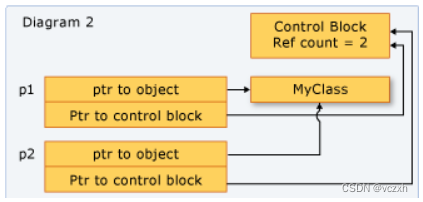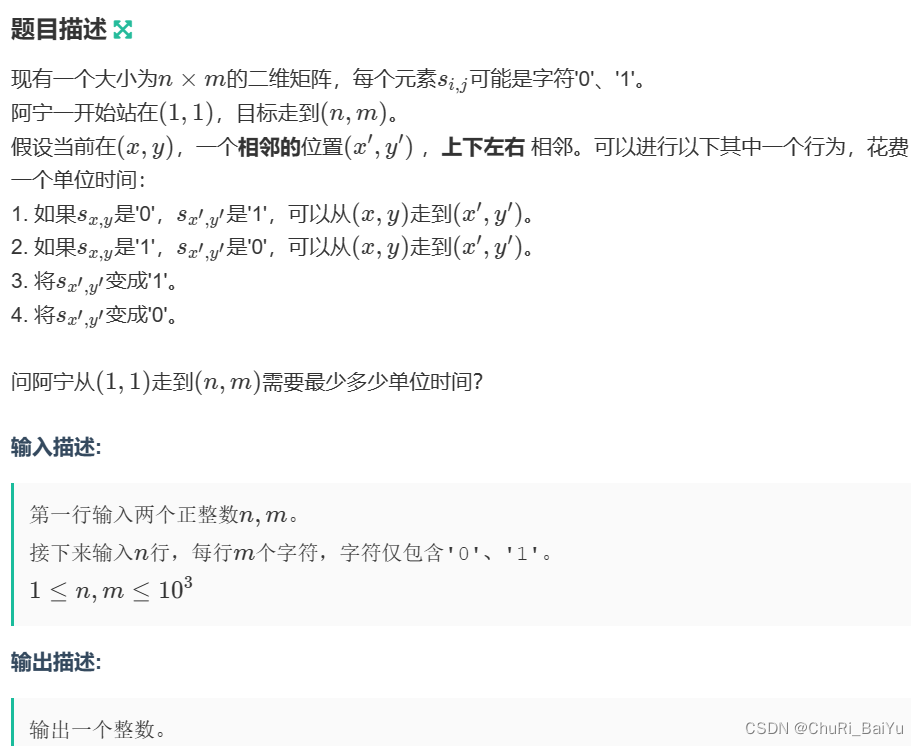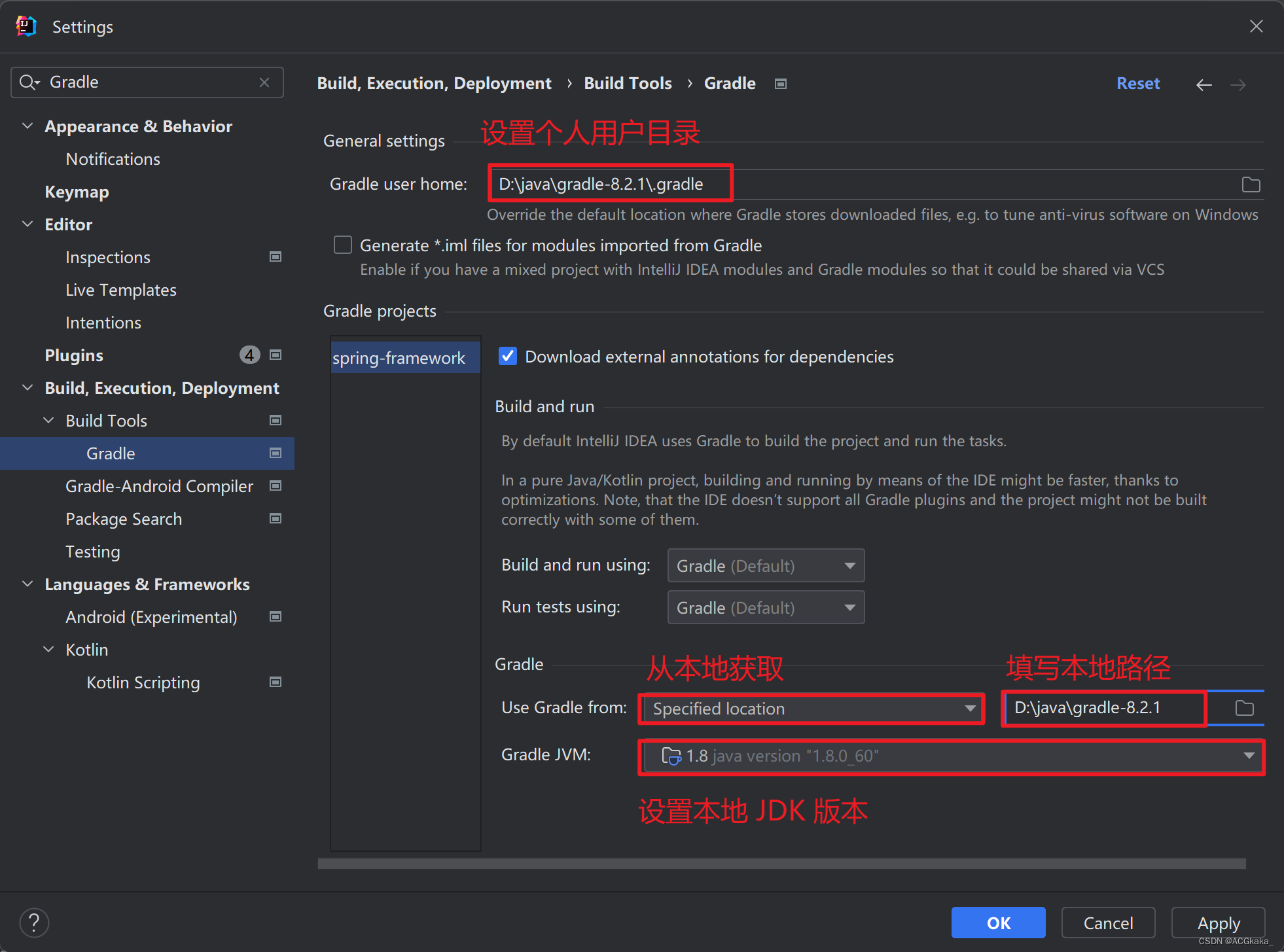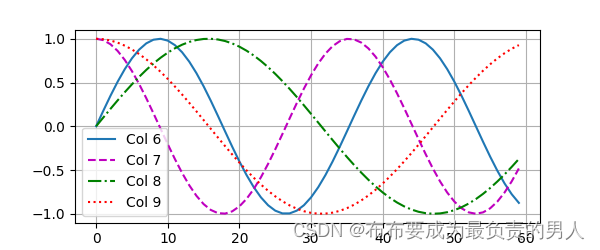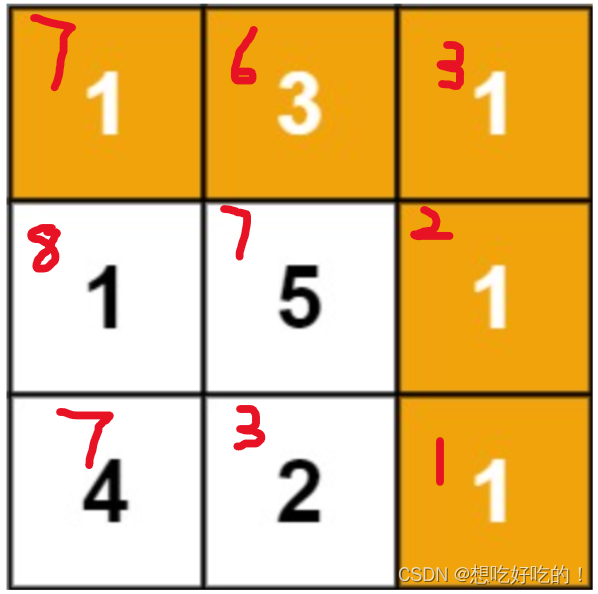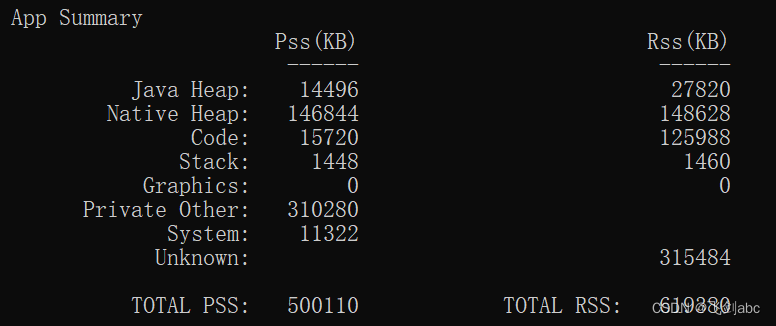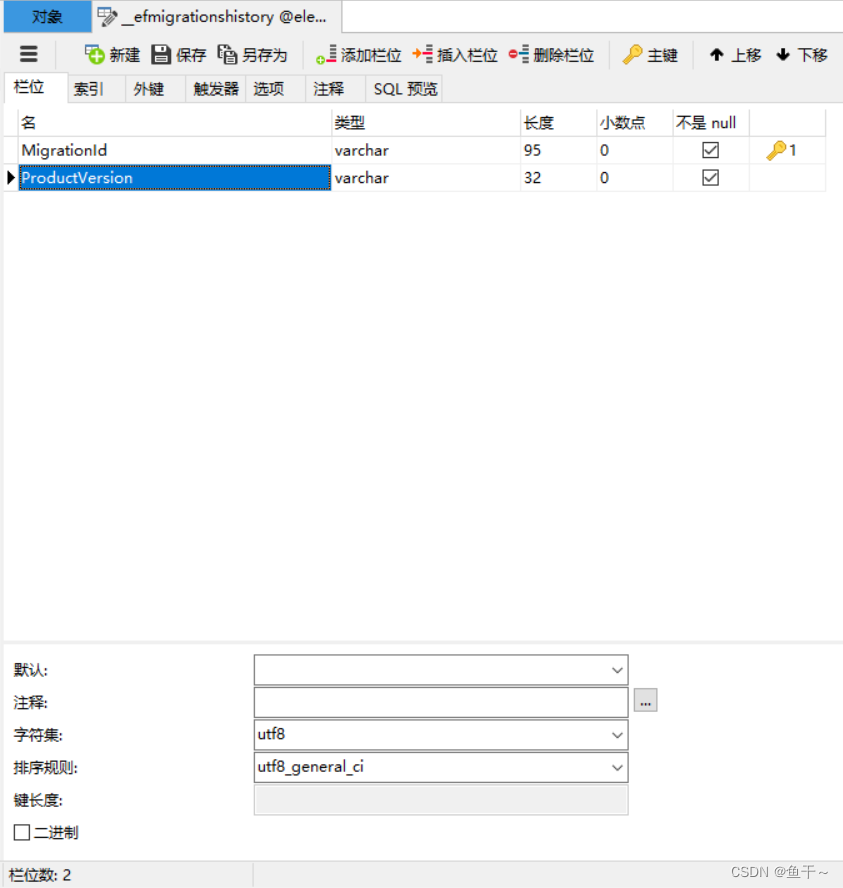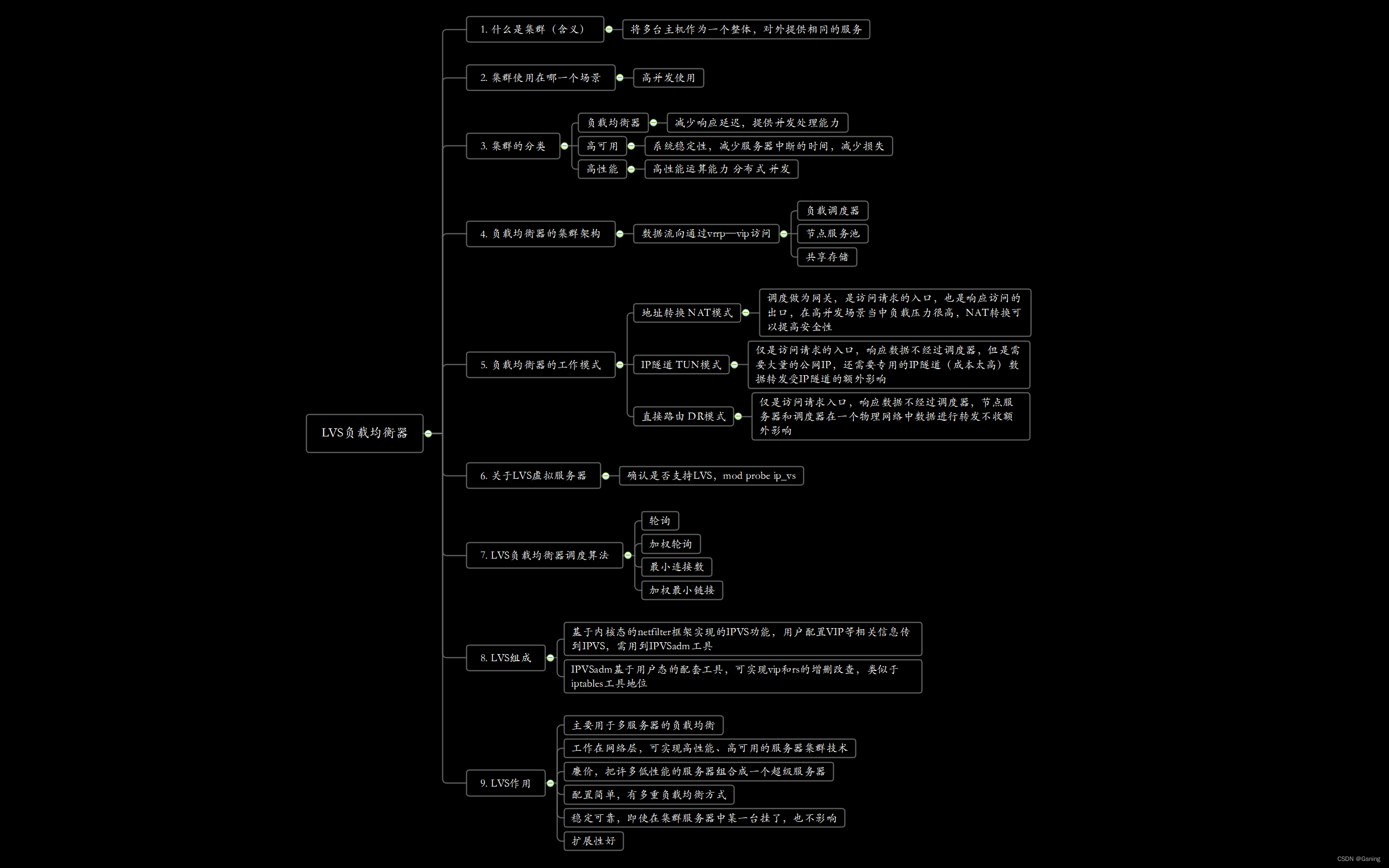C++提高编程
本阶段主要针对C++泛型编程和STT技术做详细讲解,探讨C++更深层的使用
1模板
1.1模板的概念
模板就是建立通用的模具,大大提高复用性
例如生活中的模板
寸照片模板:
1.2函数模板
- C++另一种编程思想称为 泛型编程,主要利用的技术就是模板
- C++提供两种模板机制:函数模板和类模板
1.2.1函数模板语法
函数模板作用:
建立一个通用函数,其函数返回值类型和形参类型可以不具体制定,用一个虚拟的类型来代表。
语法:
//函数声明或定义
template<typename T>
解释:
- template —— 声明创建模板
- typename —— 表面其后面的符号是一种数据类型,可以用class代替
- T —— 通用的数据类型,名称可以替换,通常为大写字母
#include<iostream>;
using namespace std;
//两个整型交换函数
void swapInt(int &a, int &b)
{
int temp = a;
a = b;
b = temp;
}
//函数模板
template<typename T>//声明一个模板,告诉编译器后面代码中紧跟着的T不要报错,T是一个通用数据类型。
void mySwap(T& a, T& b)
{
T temp = a;
a = b;
b = temp;
}
//交换两个浮点型函数
void swapDouble(double& a, double& b)
{
double temp = a;
a = b;
b = temp;
}
//测试
void test01()
{
int a = 10;
int b = 20;
/*swapInt(a,b);*/
//利用函数模板交换
//两种方式使用函数模板
//1、自动类型推导
//mySwap(a,b);
//2、显示指定类型
mySwap<int>(a, b);
cout << "a=" << a << endl;
cout << "b=" << b << endl;
//double c = 1.1;
//double d = 2.2;
//swapDouble(c, d);
//cout << "c=" << c << endl;
//cout << "d=" << d << endl;
}
//函数模板
int main()
{
test01();
system("pause");//按任意键继续
return 0;
}总结:
- 函数模板利用关键字 template
- 使用函数模板有两种方式:自动类型推导、显示指定类型
- 模板的目的是为了提高复用性,将类型参数化
1.2.2函数模板注意事项
注意事项:
- 自动类型推导,必须推导出---致的数据类型T,才可以使用
- 模板必须要确定出T的数据类型,才可以使用
#include<iostream>;
using namespace std;
//函数模板注意事项
template<typename T>//typename可以替换class
void mySwap(T&a, T&b)
{
T temp = a;
a = b;
b = temp;
}
//1、自动类型推导,必须推导出一致的数据类型T才可以使用。
void test01()
{
int a = 10;
int b = 20;
char c = 'c';
mySwap(a, b);//正确
//mySwap(a, c);//错误!!!推导不出一致的T类型。
cout << "a=" << a << endl;
cout << "b=" << b << endl;
}
//2、模板必须要确定出T的数据类型,才可以使用。
template<typename T>//typename可以替换class
void func()
{
cout << "func 调用" << endl;
}
void test02()
{
func<int>();
}
//主函数
int main()
{
test01();
test02();
system("pause");//按任意键继续
return 0;
}总结
使用模板时必须确定出通用数据类型T,并且能够推导出一致的类型
1.2.3函数模板案例
案例描述:
- 利用函数模板封装一个排序的函数,可以对不同数据类型数组进行排序
- 排序规则从大到小,排序算法为选择排序
- 分别利用char数组和int数组进行测试
#include<iostream>;
using namespace std;
//实现通用 对数组进行排序的函数
//规则 从大到小
//算法 选择
//测试 char 数组、int数组
//交换函数模板
template<typename T>
void mySawp(T& a, T& b)
{
T temp = a;
a = b;
b = temp;
}
//排序算法
template<typename T>
void mySort(T arr[],int len)
{
for (int i = 0; i < len; i++)
{
//认定的最大值 比 遍历出的数值 要小,说明j下标的元素才是真正的最大值
int max = i;//认定最大值的下标
for (int j = i + 1; j < len; j++)
{
if (arr[max] < arr[j])
{
max = j;//更新最大值下标
}
}
if (max != i)
{
//交换max和i元素
mySawp(arr[max], arr[i]);
}
}
}
//打印数组的模板
template<typename T>
void printArray(T arr[], int len)
{
for (int i = 0; i < len; i++)
{
cout << arr[i] << " ";
}
cout << endl;
}
//测试
void test01()
{
//测试char数组
char charArr[] = "badcfe";
int num = sizeof(charArr) / sizeof(char);
mySort(charArr, num);
printArray(charArr, num);
}
void test02()
{
//测试int数组
int intArr[] = {7,5,1,3,9,2,4,6,8};
int num = sizeof(intArr) / sizeof(int);
mySort(intArr, num);
printArray(intArr, num);
}
int main()
{
test01();
test02();
system("pause");//按任意键继续
return 0;
}1.2.4 普通函数与函数模板的区别
普通函数与函数模板区别:
- 普通函数调用时可以发生自动类型转换 (隐式类型转换)
- 函数模板调用时,如果利用自动类型推导,不会发生隐式类型转换
- 如果利用显示指定类型的方式,可以发生隐式类型转换
#include<iostream>;
using namespace std;
//普通函数与函数模板区别:
//1、普通函数调用可以发生隐式类型转换
//2、函数模板 用自动类型推导,不可以发生隐式类型转换
//3、函数模板 用显示指定类型,可以发生隐式类型转换
//普通函数
int myAdd01(int a, int b)
{
return a + b;
}
//函数模板
template<typename T>
T myAdd02(T a, T b)
{
return a + b;
}
void test01()
{
int a = 10;
int b = 20;
char c = 'c';//a——97 c——99;
cout << myAdd01(a, b) << endl;
cout << myAdd01(a, c) << endl;
//自动类型推导 不会发生隐式类型转换
cout << myAdd02(a, b) << endl;
//cout << myAdd02(a, c) << endl;//错误!!!
//显示指定类型 会发生隐式类型转换
cout << myAdd02<int>(a, c) << endl;
}
int main()
{
test01();
system("pause");//按任意键继续
return 0;
}总结: 建议使用显示指定类型的方式,调用函数模板,因为可以自己确定通用类型T。
1.2.5 普通函数与函数模板的调用规则
调用规则如下:
1.如果函数模板和普通函数都可以实现,优先调普通函数
2.可通过空模板参数列表强制调用函数模板
3.函数模板也可以发生重载
4.如果函数模板可以产生更好的匹配,优先调用函数模板
#include<iostream>;
using namespace std;
//普通函数与函数模板调用规则
//1、如果函数模板和普通函数都可以调用,优先调用普通函数
//2、可以通过空模板参数列表 强制调用 函数模板
//3、函数模板可以发生函数重载
//4、如果函数模板可以产生更好的匹配,优先调用函数模板
void myPrint(int a, int b)
{
cout << "调用的普通函数" << endl;
}
template<typename T>
void myPrint(T a, T b)
{
cout << "调用的函数模板" << endl;
}
template<typename T>
void myPrint(T a, T b,T c)
{
cout << "调用重载的函数模板" << endl;
}
void test01()
{
int a = 10;
int b = 20;
//myPrint(a, b);
//通过空模板参数列表,强制调用函数模板
myPrint<>(a, b);
myPrint(a, b,100);//函数重载
//如果函数模板产生更好的匹配,优先调用函数模板
char c1 = 'a';
char c2 = 'b';
myPrint(c1,c2);//调用函数模板
}
int main()
{
test01();
system("pause");//按任意键继续
return 0;
}总结: 既然提供了函数模板,最好就不要捷供普通函数,否则容易出现二义性
1.2.6 模板的局限性
局限性:
模板的通用性并不是万能的
#include<iostream>;
using namespace std;
#include<string>;
//模板的局限性
//模板并不是万能的,有些特定的数据类型,需要用具体化方式做特殊实现
class Person
{
public:
Person(string name, int age)
{
this->m_name = name;
this->m_age = age;
}
//姓名
string m_name;
//年龄
int m_age;
};
//对比两个数据是否相等函数
template<typename T>
bool myCompare(T& a, T& b)
{
if (a == b)
{
return true;
}
else
{
return false;
}
}
//利用具体化Person的版本实现代码,具体化优先调用
template<>bool myCompare(Person& p1, Person& p2)
{
if (p1.m_name == p2.m_name && p1.m_age == p2.m_age)
{
return true;
}
else
{
return false;
}
}
void test01()
{
int a = 10;
int b = 20;
bool ret = myCompare(a, b);
if (ret)
{
cout << "a==b" << endl;
}
else
{
cout << "a!=b" << endl;
}
}
void test02()
{
Person p1("Tom", 10);
Person p2("Tom", 10);
bool ret = myCompare(p1, p2);
if (ret)
{
cout << "p1==p2" << endl;
}
else
{
cout << "p1!=p2" << endl;
}
}
int main()
{
test01();
test02();
system("pause");//按任意键继续
return 0;
}总结:
- 利用具体化的模板,可以解决自定义类型的通用化
- 学习模板并不是为了写模板,而是在STL能够运用系统提供的模板
1.3类模板
1.3.1类模板语法
类模板作用
- 建立一个通用类,类中的成员 数据类型可以不具体制定,用一个虚拟的类型来代表。
template<typename T>
类
解释:
Template——声明创建模板
Typename——表面其后面的符号是一种数据类型,可以用class代替
T——通用的数据类型,名称可以替换,通常为大写字母
#include<iostream>;
using namespace std;
#include<string>;
//类模板
template<class NameType,class AgeType>
class Person
{
public:
Person(NameType name, AgeType age)//成员函数
{
this->m_Name = name;
this->m_Age = age;
}
void showPerson()
{
cout << "name:"<<this->m_Name <<" age:"<<this->m_Age << endl;
}
NameType m_Name;
AgeType m_Age;
};
//测试
void test01()
{
Person<string,int> p1("孙悟空",999);
p1.showPerson();
}
int main()
{
test01();
system("pause");//按任意键继续
return 0;
}总结:类模板和函数模板语法相似,在声明模板template后面加类,此类称为类模板。
1.3.2 类模板与函数模板区别
类模板与函数模板区别主要有两点:
1.类模板没有自动类型推导的使用方式
2.类模板在模板参数列表中可以有默认参数
#include<iostream>;
using namespace std;
#include<string>;
//类模板与函数模板区别主要有两点:
template<class NameType,class AgeType = int>//仅类模板可以使用int
class Person
{
public:
Person(NameType name, AgeType age)//成员函数
{
this->m_Name = name;
this->m_Age = age;
}
void showPerson()
{
cout << "name:"<<this->m_Name <<" age:"<<this->m_Age << endl;
}
NameType m_Name;
AgeType m_Age;
};
//1.类模板没有自动类型推导的使用方式
void test01()
{
//Person p("孙悟空", 1000);//错误,无法用自动类型推导
Person<string,int> p("孙悟空",1000);//正确,只能用显示指定类型
p.showPerson();
}
//2.类模板在模板参数列表中可以有默认参数
void test02()
{
Person<string> p("猪八戒", 999);
p.showPerson();
}
int main()
{
test01();
test02();
system("pause");//按任意键继续
return 0;
}总结:
- 类模板使用只能用显示指定类型方式。
- 类模板中的模板参数列表可以有默认参数。
1.3.3 类模板中成员函数创建时机
类模板中成员函数和普通类中成员函数创建时机是有区别的:
- 普通类中的成员函数一开始就可以创建
- 类模板中的成员函数在调用时才创建
#include<iostream>;
using namespace std;
#include<string>;
//普通类中的成员函数一开始就可以创建
//类模板中的成员函数在调用时才创建
class Person1
{
public:
void showPerson1()
{
cout << "Person1 show" << endl;
}
};
class Person2
{
public:
void showPerson2()
{
cout << "Person2 show" << endl;
}
};
template<class T>
class MyClass
{
public:
T obj;
//类模板中的成员函数
void func1()
{
obj.showPerson1();
}
void func2()
{
obj.showPerson2();
}
};
//测试
void test01()
{
MyClass<Person1>m;
m.func1();
//MyClass<Person2>m;
//m.func2();
}
int main()
{
test01();
system("pause");//按任意键继续
return 0;
}总结:模板中的成员函数并不是一开始就创建的,在调用时才去创建。
1.3.4 类模板对象做函数参数
学习目标:
- 类模板实例化出的对象,向函数传参的方式
一共有三种传入方式
1.指定传入的类型 ——直接显示对象的数据类型
2.数模板化 ——将对象中的参数变为模板进行传递
3.整个类模板化 ——将这个对象类型 模板化进行传递
#include<iostream>;
using namespace std;
#include<string>;
//类模板对象做函数参数
template<class T1,class T2>
class Person
{
public:
Person(T1 name,T2 age)
{
this->m_Name = name;
this->m_Age = age;
}
void showPerson()
{
cout << "姓名:" << this->m_Name << " 年龄:" << this->m_Age << endl;
}
T1 m_Name;
T2 m_Age;
};
//1、指定传入的类型——常用方式。
void printPerson1(Person<string,int>&p)//引用
{
p.showPerson();
}
void test01()
{
Person<string, int>p("孙悟空",100);
printPerson1(p);
}
//2、参数模板化
template<class T1, class T2>
void printPerson2(Person<T1,T2>&p)//引用
{
p.showPerson();
cout << "T1的类型为:" << typeid(T1).name() << endl;//查看数据中的类型命令。
cout << "T2的类型为:" << typeid(T2).name() << endl;
}
void test02()
{
Person<string, int>p("猪八戒", 90);
printPerson2(p);
}
//3、整个类模板化
template<class T>
void printPerson3( T &p )//引用
{
p.showPerson();
cout << "T的类型为:" << typeid(T).name() << endl;//查看数据中的类型命令。
}
void test03()
{
Person<string, int>p("唐僧", 30);
printPerson3(p);
}
int main()
{
test01();
test02();
test03();
system("pause");//按任意键继续
return 0;
}总结:
- 通过类模板创建的对象,可以有三种方式向函数中进行传参
- 使用比较止泛是第一种:指定传入的类型
1.3.5 类模板与继承
当类模板碰到继承时,需要注意一下几点:
- 当子类继承的父类是一个类模板时,子类在声明的时候,要指定出父类中T的类型
- 如果不指定,编译器无法给子类分配内存
- 如果想灵活指定出父类中T的类型,子类也需变为类模板
#include<iostream>;
using namespace std;
#include<string>;
//类模板与继承
template<class T>
class Base
{
public:
T m;
};
//class Son:public Base//错误,必须要知道父类中的T类型,才能继承给子类。
//1、当子类继承的父类是一个类模板时,子类在声明的时候,要指定出父类中T的类型
class Son1:public Base<int>//继承
{
public:
};
//测试
void test01()
{
Son1 s1;
}
//2、如果想灵活指定出父类中T的类型,子类也需变为类模板
template<class T1,class T2>
class Son2 :public Base<T2>//继承
{
public:
Son2()
{
cout << "T1的类型为:" << typeid(T1).name() << endl;
cout << "T2的类型为:" << typeid(T2).name() << endl;
}
T1 obj;
};
void test02()
{
Son2<int,char>s2;
}
int main()
{
test01();
test02();
system("pause");//按任意键继续
return 0;
}总结:如果父类是类模板,子类需要指定出父类中T的数据类型。
#include<iostream>;
using namespace std;
#include<string>;
//类模板成员函数类外实现
template<class T1,class T2>
class Person
{
public:
Person(T1 name, T2 age);
/*{
this->m_Name = name;
this->m_Age = age;
}*/
void showPerson();
/*{
cout << "姓名:" << this->m_Name << " 年龄:" << this->m_Age << endl;
}*/
T1 m_Name;
T2 m_Age;
};
//构造函数的类外实现
template<class T1, class T2>
Person<T1,T2>::Person(T1 name, T2 age)
{
this->m_Name = name;
this->m_Age = age;
}
//成员函数类外实现
template<class T1, class T2>
void Person<T1, T2>::showPerson()
{
cout << "姓名:" << this->m_Name << " 年龄:" << this->m_Age << endl;
}
//测试
void test01()
{
Person<string, int>P("Tom", 20);
P.showPerson();
}
int main()
{
test01();
system("pause");//按任意键继续
return 0;
}总结:类模板中成员函数类外实现时,需要加上模板参数列表。
1.3.7 类模板分文件编写
学习目标:
- 掌握类模板成员函数分文件编写产生的问题以及解决方式
问题:
- 类模板中成员函数创建时机是在调用阶段,导致分文件编写时链接不到
解决:
- 解决方式1:直接包含.cpp源文件
- 解决方式2:将声明和实现写到同一个文件中,并更改后缀名为.hpp,hpp是约定的名称,并不是强制
示例:
Person.hpp中代码:
#pragma once
#include<iostream>;
using namespace std;
#include<string>;
//类模板分文件编写问题以及解决
template<class T1, class T2>
class Person
{
public:
Person(T1 name, T2 age);
void showPerson();
public:
T1 m_Name;
T2 m_Age;
};
//构造函数的类外实现
template<class T1, class T2>
Person<T1,T2>::Person(T1 name, T2 age)
{
this->m_Name = name;
this->m_Age = age;
}
//成员函数类外实现
template<class T1, class T2>
void Person<T1, T2>::showPerson()
{
cout << "姓名:" << this->m_Name << " 年龄:" << this->m_Age << endl;
}类模板分文件编写.cpp中代码:
#include<iostream>
using namespace std;
//第一种方式,直接包含 源文件
//#include"person.cpp"
//第二种解决方式,将.h和.cpp中的内容写到一起,将后缀名改为.hpp文件
#include"person.hpp"
类模板分文件编写问题以及解决
//template<class T1,class T2>
//class Person
//{
//public:
// Person(T1 name, T2 age);
// void showPerson();
// T1 m_Name;
// T2 m_Age;
//};
构造函数的类外实现
//template<class T1, class T2>
//Person<T1,T2>::Person(T1 name, T2 age)
//{
// this->m_Name = name;
// this->m_Age = age;
//}
成员函数类外实现
//template<class T1, class T2>
//void Person<T1, T2>::showPerson()
//{
// cout << "姓名:" << this->m_Name << " 年龄:" << this->m_Age << endl;
//}
//测试
void test01()
{
Person<string, int>p("Jerry", 18);
p.showPerson();
}
int main()
{
test01();
system("pause");//按任意键继续
return 0;
}总结:主流的解决方式是第二种,将类模板成员函数写到一起,并将后缀名改为.hpp
1.3.8 类模板与友元
学习目标:
- 掌握类模板配合友元函数的类内和类外实现
全局函数类内实现——直接在类内声明友元即可
全局函数类外实现——需要提前让编译器知道全局函数的存在
#include<iostream>;
using namespace std;
#include<string>;
//类模板与友元
//通过全局函数 打印Person信息
//提前让编译器知道Person类存在
template<class T1, class T2>
class Person;
//类外实现
template<class T1, class T2>
void printPerson2(Person<T1, T2>& p)
{
cout << "类外实现——姓名:" << p.m_Name << " 年龄" << p.m_Age << endl;
}
template<class T1, class T2>
class Person
{
//全局函数 类内实现
friend void printPerson(Person<T1,T2>p)
{
cout << "姓名:" << p.m_Name << " 年龄" << p.m_Age << endl;
}
//全局函数 类外实现
//加空模板参数列表<>
//如果全局函数 是类外实现,需要让编译器提前知道这个函数的存在
friend void printPerson2<>(Person<T1, T2>& p);//普通函数声明
public:
Person(T1 name, T2 age)
{
this->m_Name = name;
this->m_Age = age;
}
private:
T1 m_Name;
T2 m_Age;
};
//1、全局函数在类内实现
void test01()
{
Person<string, int>p("Tom", 20);
printPerson(p);
}
//2、全局函数在类外实现
void test02()
{
Person<string, int>p("Jerry", 20);
printPerson2(p);
}
int main()
{
test01();
test02();
system("pause");//按任意键继续
return 0;
}总结:建议全局函教做类内实现,用法简单,而且编译器可以直接识别
1.3.9 类模板案例
案例描述:实现一个通用的数组类,要求如下:
- 可以对内置数据类型以及自定义数据类型的数据进行存储
- 将数组中的数据存储到堆区
- 构造函数中可以传入数组的容量
- 提供对应的拷贝构造函数以及operator=防止浅拷贝问题
- 提供尾插法和尾删法对数组中的数据进行增加和删除
- 可以通过下标的方式访问数组中的元素
- 可以获取数组中当前元素个数和数组的容量
思路分析:
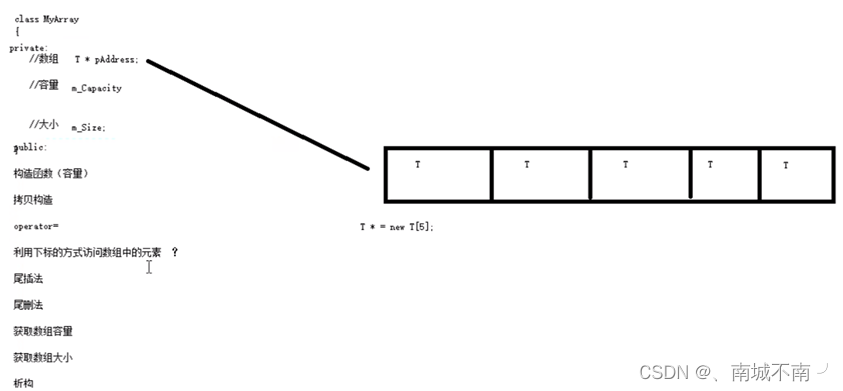
MyArrey.hpp中的代码:
//自己的通用的数组类
#pragma once
#include<iostream>
using namespace std;
template<class T>
class MyArrey
{
public:
//有参构造 参数 容量
MyArrey(int capacity)
{
cout << "MyArrey有参构造调用" << endl;
this->m_Capacity = capacity;
this->m_Size = 0;
this->pAddress = new T[this->m_Capacity];
}
//拷贝构造
MyArrey(const MyArrey& arr)
{
cout << "MyArrey拷贝构造调用" << endl;
this->m_Capacity = arr.m_Capacity;
this->m_Size = arr.m_Size;
//this->pAddress = arr.pAddress;//错误!!!浅拷贝
//深拷贝
this->pAddress = new T[arr.m_Capacity];
//将arr中的数据都拷贝过来
for (int i = 0; i < this->m_Size; i++)
{
this->pAddress[i] = arr.pAddress[i];
}
}
//operator= 防止浅拷贝问题 a = b = c
MyArrey& operator=(const MyArrey& arr)
{
cout << "MyArrey 的 operator= 调用" << endl;
//判断原来堆区是否有数据,如果有先释放
if (this->pAddress != NULL)
{
delete[] this->pAddress;
this->pAddress = NULL;
this->m_Capacity = 0;
this->m_Size = 0;
}
//深拷贝
this->m_Capacity = arr.m_Capacity;
this->m_Size = arr.m_Size;
this->pAddress = new T[arr.m_Capacity];
//将arr中的数据都拷贝过来
for (int i = 0; i < this->m_Size; i++)
{
this->pAddress[i] = arr.pAddress[i];
}
return *this;
}
//析构函数
~MyArrey()
{
if (this->pAddress!=NULL)
{
cout << "MyArrey析构函数调用" << endl;
delete[] this->pAddress;
this->pAddress = NULL;
}
}
private:
T* pAddress;//指针指向堆区开辟的真实数组
int m_Capacity;//数组的容量
int m_Size;//数组大小
};类模板案例-数组类封装.cpp中的代码:
#include<iostream>;
using namespace std;
#include<string>;
#include"MyArray.hpp"
void test01()
{
MyArrey<int>arr1(5);
MyArrey<int>arr2(arr1);
MyArrey<int>arr3(100);
arr3 = arr1;
}
int main()
{
test01();
system("pause");//按任意键继续
return 0;
}尾插法/尾删法——案例完整代码:
MyArrey.hpp中的代码:
//自己的通用的数组类
#pragma once
#include<iostream>
using namespace std;
template<class T>
class MyArray
{
public:
//有参构造 参数 容量
MyArray(int capacity)
{
cout << "MyArray有参构造调用" << endl;
this->m_Capacity = capacity;
this->m_Size = 0;
this->pAddress = new T[this->m_Capacity];
}
//拷贝构造
MyArray(const MyArray& arr)
{
cout << "MyArray拷贝构造调用" << endl;
this->m_Capacity = arr.m_Capacity;
this->m_Size = arr.m_Size;
//this->pAddress = arr.pAddress;//错误!!!浅拷贝
//深拷贝
this->pAddress = new T[arr.m_Capacity];
//将arr中的数据都拷贝过来
for (int i = 0; i < this->m_Size; i++)
{
this->pAddress[i] = arr.pAddress[i];
}
}
//operator= 防止浅拷贝问题 a = b = c
MyArray& operator=(const MyArray& arr)
{
cout << "MyArray 的 operator= 调用" << endl;
//判断原来堆区是否有数据,如果有先释放
if (this->pAddress != NULL)
{
delete[] this->pAddress;
this->pAddress = NULL;
this->m_Capacity = 0;
this->m_Size = 0;
}
//深拷贝
this->m_Capacity = arr.m_Capacity;
this->m_Size = arr.m_Size;
this->pAddress = new T[arr.m_Capacity];
//将arr中的数据都拷贝过来
for (int i = 0; i < this->m_Size; i++)
{
this->pAddress[i] = arr.pAddress[i];
}
return *this;
}
//尾插法20230817
void Push_Back(const T & val)
{
//判断容量是否等于大小
if (this->m_Capacity == this->m_Size)
{
return;
}
this->pAddress[this->m_Size] = val;//在数组末尾插入数据
this->m_Size++;//更新数组大小
}
//尾删法
void Pop_Back()
{
//让用户访问不到最后一个元素,即为尾删,逻辑删除。
if (this->m_Size == 0)
{
return;
}
this->m_Size--;
}
//通过下标方式访问数组中的元素 arr[0]=100。//重载operator
T& operator[](int index)//下标
{
return this->pAddress[index];
}
//返回数组的容量
int getCapacity()
{
return this->m_Capacity;
}
//返回数组的大小
int getSize()
{
return this->m_Size;
}
//析构函数
~MyArray()
{
if (this->pAddress!=NULL)
{
cout << "MyArray析构函数调用" << endl;
delete[] this->pAddress;
this->pAddress = NULL;
}
}
private:
T* pAddress;//指针指向堆区开辟的真实数组
int m_Capacity;//数组的容量
int m_Size;//数组大小
};类模板案例-数组类封装.cpp中的代码:
#include<iostream>;
using namespace std;
#include<string>;
#include"MyArray.hpp"
void printIntArray(MyArray<int>&arr)
{
for (int i = 0; i < arr.getSize(); i++)
{
cout << arr[i] << endl;
}
}
void test01()
{
MyArray<int>arr1(5);
for (int i = 0; i < 5; i++)
{
//利用尾插法向数组中插入数据
arr1.Push_Back(i);
}
cout << "arr1的打印输出为:" << endl;
printIntArray(arr1);
cout << "arr1的容量为:" << arr1.getCapacity() << endl;
cout << "arr1的大小为:" << arr1.getSize() << endl;
MyArray<int>arr2(arr1);
cout << "arr2的打印输出为:" << endl;
printIntArray(arr2);
//尾删
arr2.Pop_Back();
cout << "arr2尾删后:" << endl;
cout << "arr2的容量为:" << arr2.getCapacity() << endl;
cout << "arr2的大小为:" << arr2.getSize() << endl;
/*MyArray<int>arr3(100);
arr3 = arr1;*/
}
//测试自定义的数据类型
class Person
{
public:
Person() {};
Person(string name, int age)
{
this->m_Name = name;
this->m_Age = age;
}
string m_Name;
int m_Age;
};
void printPersonArray(MyArray<Person> &arr)
{
for (int i = 0; i < arr.getSize(); i++)
{
cout << "姓名:" << arr[i].m_Name << "年龄" << arr[i].m_Age << endl;
}
}
void test02()
{
MyArray<Person> arr(10);
Person p1("孙悟空",999);
Person p2("韩信", 30);
Person p3("妲己", 20);
Person p4("赵云", 25);
Person p5("安其拉", 27);
//将数据插入到数组中
arr.Push_Back(p1);
arr.Push_Back(p2);
arr.Push_Back(p3);
arr.Push_Back(p4);
arr.Push_Back(p5);
//打印数组
printPersonArray(arr);
//输出容量
cout << "arr的容量为:" << arr.getCapacity() << endl;
//输出大小
cout << "arr的大小为:" << arr.getSize() << endl;
}
int main()
{
test01();
test02();
system("pause");//按任意键继续
return 0;
}总结:
能够利用所学知识点实现通用的数组
模板结束。


